|
|||||||||
|
NEW SCHOLARSHIPBOOK REVIEW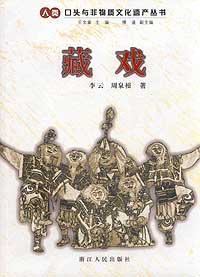 LI YUN AND ZHOU QUANGEN, TIBETAN OPERA (ZANGXI), HANGZHOU: ZHEJIANG RENMIN CHUBANSHE, 2005, 210pp.As a student of Chinese cultures in the general sense, I must confess to having long been wary of the theatrical entity dubbed 'Tibetan opera'. Most early Western writing focused on the sacred dimensions of 'theatrical' performances in Tibetan monasteries. My scepticism was reinforced during the early post-Cultural revolution period by the slim offerings of ethnic song and dance troupes (Fig. 1), and it always seemed to me that the Tibetan Autonomous Region (TAR) had been presented by the Chinese central government with a prêt-a-porter 'opera' genre so that Tibet's dramatic traditions could match perfectly and integrate with the cultural styles of other members of the family of Chinese dramatic forms. 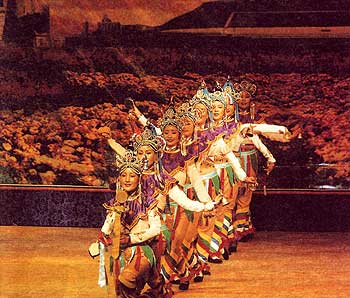 Fig. 1 Performance of a dance scene adapted from a Tibetan drama and performed by the Tibetan Drama Troupe. It was only when travelling in Qinghai that I became acquainted with the hometown, career and exploits of Gedun Chopel (1903-1951), possibly one of the most remarkable modern Tibetan intellectuals, and began to question my initial dismissive assumptions. Among the many achievements of the reform-minded Gedun Chopel was his active involvement in the development of a repertoire of plays performed by artists under the tutelage of Labrang Monastery located in Gansu province, but geographically close to the cultural heartland of Tibetan Amdo, known today as Qinghai. Several popular Chinese biographies of Gedun Chopel explain that what was significant about these plays pioneered at Labrang were that they were secular and intended for a general audience, marking a break with the Tibetan tradition of sacred performances within the confines of the monastery for the exclusive enjoyment of the religious. The dramatic innovations at Labrang were contemporary with and seem to echo cultural developments in China's coastal ports during the early years of the Republican period. Gedun Chopel was thus also a pioneer in 'Chinese' theatre reform, and it is well known that his rebellious intellectual and political stance resulted in his imprisonment by the 13th Dalai Lama in the Republican period. 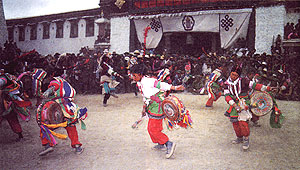 Fig. 2 Scene of Tibetan folk dancing (intangible cultural heritage items nos.123 and 142). After reading Li Yuan and Zhou Quangen's Tibetan opera, I think that my original suspicions regarding this artistic Über-category were instinctively well-grounded. The welding together of dramatic, invocatory, liturgical, dance (Fig. 2), mime and song performance styles, once loosely but erroneously termed in English 'mystery plays' or even 'devil dances', from disparate monastic and secular festival traditions across the Qinghai-Tibetan plateau (Fig. 3), or even the wider ethnic domain sometimes referred to as Greater Tibet, into a form of theatre called in Chinese Zangxi (Tibetan opera, the inexact equivalent of the Tibetan lha-mo) represents a process that seems more administrative and bureaucratic than cultural and organic. 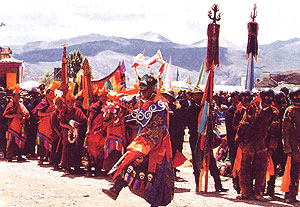 Fig. 3 Performance of Cham (Chinese: qiangmu) on occasion of Dama festival in Gyangze (Jiangzi), Tibet Zangxi was listed as 'intangible cultural heritage property' no.224 on the State Council's list of 518 properties issued on 20 May 2006. It takes its place on that list with other ethnic-denoted operas, i.e., Zhuang opera (no.226), Dong opera (no.227), Bouyei opera (no.228) and Dai opera (no.230). Tibetan opera, nominated by the governments of TAR and the Huangnan Tibetan Autonomous Prefecture of Qinghai province, is defined in its listing as a composite category comprising the following performance traditions: the Kyimulungma of Lhasa, the Chungba and Gyangara of Xigaze, as well as two traditions from the Shannan district of the TAR, a third tradition from Xigaze, also in the TAR, and one tradition from the Huangnan Tibetan Autonomous Prefecture of Qinghai. 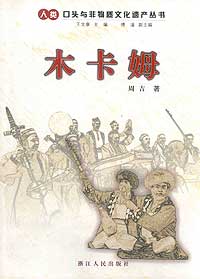 Fig. 4 Cover of Zhou Ji, Mukamu, Zhejiang Renmin Chubanshe, 2005. 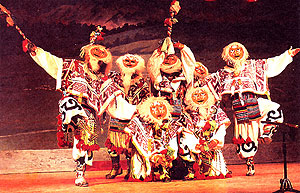 Fig. 5 Opening scene from white mask drama of Tibetan drama based in Lhasa Few informed accounts for the generalist reader interested in Tibetan opera have appeared in Chinese in the PRC, so this recently published and accessible work by Li Yun and Zhou Quangen is welcome. As part of the 'Mankind's Oral and Intangible Cultural Heritage Series' that has appeared over the last three years under the auspices of the China Arts Academy, it also goes part of the way to explaining China's efforts to preserve its intangible cultural heritage and have it listed by UNESCO. To date, six volumes have appeared apart from the one presently under discussion. They treat: Kunqu drama; the ancient Chinese 'lute' (guqin); New Year wood-block prints; Shaolin temple kungfu; the Tibetan arts of Regong (Repkong); nanyin (a musical form of southern China); and, the muqam musical systems of Xinjiang. (Fig. 4). The last of these studies by Zhou Ji is an exciting and enthusiastic interpretation of the dynamic musical tradition that sets this Uyghur musical art form within an international context. Tibetan opera is a flawed and heavy-handed addition to the series. The term 'Tibetan opera' (Zangxi), like 'Shanghai opera' (Huju), is a neologism of the 1950s, and it represents the inclusion of a synthetic set of dramas as a single category within the rich family of Chinese regional dramatic forms. The authors explain that Zangxi must be considered as a term encompassing a number of more specific regional genres, each of which is characterised in turn by liupai or 'schools of interpretation in performance'. It is clear that Zangxi cannot be regarded in their interpretation as simply a new term for the Tibetan folk opera form called lha-mo. They identify eight major genres of Zangxi: white mask plays popular in the Lhasa and Shannan districts of the TAR, (Fig. 5) blue mask plays popular in the TAR and the Kham area of Sichuan in addition to 'areas overseas' (p.28), and ethnic Monba Tibetan opera, as well as Tibetan opera from disparate areas of 'Greater Tibet', namely Changdu, Derge, Kham, Amdo and Gyarong. Within almost all Chinese regional dramatic genres, 'schools' (liupai) are invariably named for individual performers who created a style perpetuated by their students, and in turn by their students' students. However, this is not the case with Tibetan opera as outlined here. Neither does the appellation of xi (conventionally, 'opera') for the performance arts lumped together as Zangxi (Tibetan opera) conform to the practice in China proper, nor does the understanding of 'schools', variously classified by the authors according to locality, repertoire or subject matter. In providing the historical background of the development of this intangible cultural heritage , the authors devote space to the contributions of the Fifth Dalai Lama to the development of 'white mask Tibetan opera' in the 17th century, and to some of the very early developments in other genres of Zangxi, but there is virtually no discussion of 20th century developments prior to 1949. Historically, the delineation of most of the authors' eight designated strands of Zangxi jumps from the 18th and 19th centuries straight to the 1950s. For example, the section on Amdo Zangxi (pp. 42-46) does briefly mention innovations at Labrang, such as the creation of repertoire items built around the religious and ecstatic rhapsodies of the saint Milarepa, but the authors suggest that the impetus for these innovations came from the heartland of 'Tibet Proper', an interesting twist that would probably win approval among the Tibetan diaspora centred on Dharmsala, but one that does not seem to appear in most introductory materials to Labrang's cultural history published in Chinese. Moreover, the authors date the 'invention' (chuangjian) of the unique Amdo Tibetan opera of the Gannan (southern Gansu region) to the 1940s, following the return to Labrang from Lhasa of the Fifth Jamyang-zhaypa. In discussing the 'school' of Amdo Tibetan opera called nang-ma (Chinese: nanmu), described as characterised by 'a transmitted historical repertoire', the authors write: 'Between 1954 and 1962, in Tibetan Amdo dialect areas in Repkong and Gölok (Guoluo) in Qinghai, Labrang in Gansu, and in Aba and Garzê in Sichuan, more than ten non-professional Tibetan opera troupes of this school emerged, causing Amdo drama of this type to enter a new historical period. But in 1958, because of "reasons of history", such dramas were no longer performed, and to this day performances of the genre have never been restored in temples'. The authors then simply list several presumably 'secular' troupes who perform this 'school' of Tibetan opera today. This refusal to mention the Tibetan uprising of 1959 which engulfed Greater Tibet seems unnecessary, and on a number of occasions in the book the authors at least acknowledge that damage was inflicted on the development of Tibetan drama by a named 'Cultural Revolution'. Such coyness in the 21st century concerning events of more than 50 years ago is unjustifiable in the enterprise of cultural heritage preservation when knowledge of damage done is essential to protecting items salvaged. The book is therefore only rendered potentially reliable for its presentation of the history of this heritage from the 1980s onwards, for which period they include material of interest, and acknowledge that it is now the task of a new generation of researchers to fill in the gaps in knowledge of the many strands in the development of what has come to be called Tibetan opera. For example, it was only at a national conference on the development of Tibetan opera in 2003 that an associate researcher from the Qinghai Provincial Arts Research Institute, Cao Yali brought to scholarly attention her discovery of the existence of a body of drama treating the legends of King Gesar in the Gölok area of central Qinghai. For the authors, their historical coverage of Tibetan opera is probably only incidental to their succinct introductions to the musical rudiments, dance elements, props and costumes, masks, festival performances and linguistic features of the genres. They provide a clear introduction of Tibetan opera as it has come to be defined, and mention the main performers and troupes keeping Tibetan dramas alive. However, if the book is to appear in future editions, one wants a coherent outline history of the thing called Zangxi, and hopes that the once and forever quality that the authors attribute to Tibetan opera is excised in favour of a clear account that signals when the term Zangxi was first used. A table providing chronological and other details of all the major performing troupes and leading players that have operated under this rubric, as well those that now do so, would go some of the way to side-stepping 'reasons of history', while paying tribute to the many artists for whom Tibetan opera is not simply an intangible cultural heritage item but a tangible source of livelihood and an emotional challenge. Within the context of China's intangible cultural heritage enterprise, the preliminary case for proposing the listing by UNESCO of Tibetan opera, though now no longer an option, is outlined (pp. 202-206). More importantly, the full text of 'The Ten Year Plan for Protecting and Invigorating the Art of Tibetan Opera' (Zangxi yishu baohu yu zhenxing shinian guihua), issued by the Department of Culture of the TAR in June 2002, is appended to the work. [BGD] Reference:Syed Jamil Ahmed, 'Tibetan Folk Opera: Lhamo in Contemporary Cultural Politics', Asian theatre journal, Honolulu: The University of Hawai'i Press, 23:1, 2006, pp.149-178. |